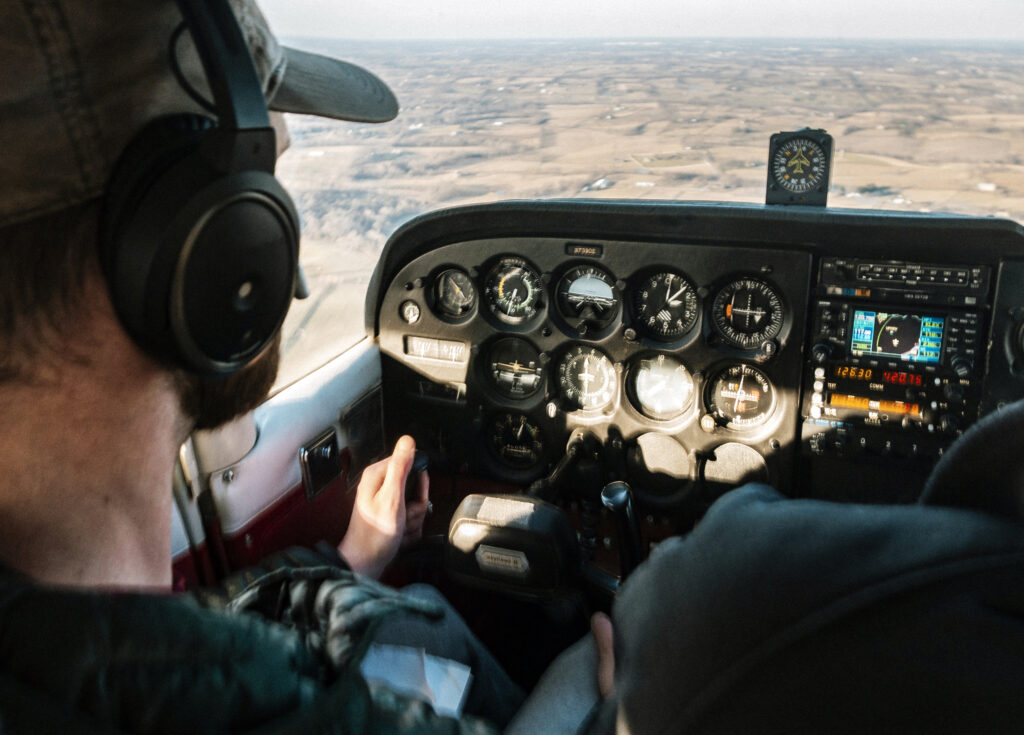INSTRUMENT RATING

What is an Instrument Rating?
Expand your ability to fly — rain, clouds, or shine — and take your training to the next level with instrument flight experience.
An Instrument Rating is an advanced pilot certification that allows pilots to fly in adverse weather conditions and through clouds using only the aircraft’s instruments for navigation and control. It enhances a pilot’s skills and capabilities, enabling safer and more efficient flying in low visibility conditions such as fog, rain, or clouds.
Prerequisite: FAA Private or Commercial Certificate
*Instrument training can be completed in any Cessna 172 in the fleet. Prices vary based on aircraft, view aircraft rental rates for more information.
Instrument Rating Requirements
PART 61
- One XC instructional IFR flight of 250 nautical miles along airways or directed routing from ATC;
- An instrument approach at each airport; and
- Three different kinds of approaches with the use of navigation systems
*Three (3) hours of flight training must be conducted within the 2 calendar months preceding the test.
Part 61 flight training provides a more flexible, less structured approach to obtaining your pilot certificates.
One main advantage of choosing a Part 61 program is that it caters to those with busy lifestyles or prior aviation knowledge who may not require the strict structure of Part 141 programs.
Students can progress at their own pace, balancing other life responsibilities with their flight hours.
Requirements:
- Hold at least a current private pilot certificate, or be concurrently applying for a private pilot certificate
- Be able to read, speak, write, and understand the English language.
- Receive appropriate endorsements from a qualified instructor
- Pass the FAA Instrument Knowledge Test (Written exam)
- Pass the FAA Practical Exam (Oral & Checkride)
- Meet aeronautical knowledge requirements of 14 CFR §61.65 (b).
- Demonstrate flight proficiency requirements of 14 CFR §61.65 (c).
- Meet the Aeronautical experience per 14 CFR §61.65 (d).
PART 141
- Follow an FAA-Approved Syllabus
- Dual Instruction from an authorized Instructor on Cross-country flight
*Three (3) hours of flight training must be conducted within the 2 calendar months preceding the test.
Part 141 flight training is designed for those who aspire to become professional pilots, offering a more formal and highly regulated learning environment. Under the Federal Aviation Regulations (FARs), Part 141 schools must adhere to an FAA-approved syllabus and strictly defined training structure.
The key components of Part 141 training include classroom instruction, stage checks conducted by authorized flight instructors, and comprehensive ground training. These training programs significantly reduce the requirements for the instrument rating.
Requirements:
- Hold at least a current private pilot certificate, or be concurrently applying for a private pilot certificate
- Be able to read, speak, write, and understand the English language.
- Receive appropriate endorsements from a qualified instructor
- Pass the FAA Instrument Knowledge Test (Written exam)
- Pass an FAA Practical Exam (Oral & Checkride)
- Complete requirements of VFA’s FAA-Approved 141 Training Course Outline (TCO)
In-House Examining Authority:
Pinnacle Aviation Academy now holds FAA examining authority for the Instrument Rating under Part 141, allowing eligible students to complete their checkride on-site with our in-house examiners. This provides a more streamlined and efficient path to certification.
Frequently Asked Questions
You need to be at least 17 years old, and hold a Current Private or Commercial Pilot Certificate.
With an Instrument Rating you are able to fly in IFR (Instrument Flight Rules) conditions. It will increase your safety knowing how to fly using instruments/non visual aids. It will also prepare you to handle any change in the weather you may encounter on a flight.
It may take 4–6 months to earn an Instrument Rating; however, there are many variables that affect how quickly one earns their rating—for example, weather delays or scheduling availability. Generally, if a student studies consistently and flies regularly, training can be completed efficiently within this timeframe.
Training for the Instrument Rating will involve a lot of flying by reference to instruments. Some of this can be accomplished in one of our flight training devices. In the aircraft, you will be doing a lot of flying “under the hood”, meaning using a view limiting device, which confines your field of view to only the flight instruments. Some of your training also may be in “actual” IFR conditions.
You can keep your Instrument Rating current in one of two ways. (1) You can perform at least six instrument approaches; perform holding procedures; and intercepting and tracking courses through the use of navigation systems every six months. (2) Alternatively, You can take an Instrument Proficiency Check with an authorized instructor.